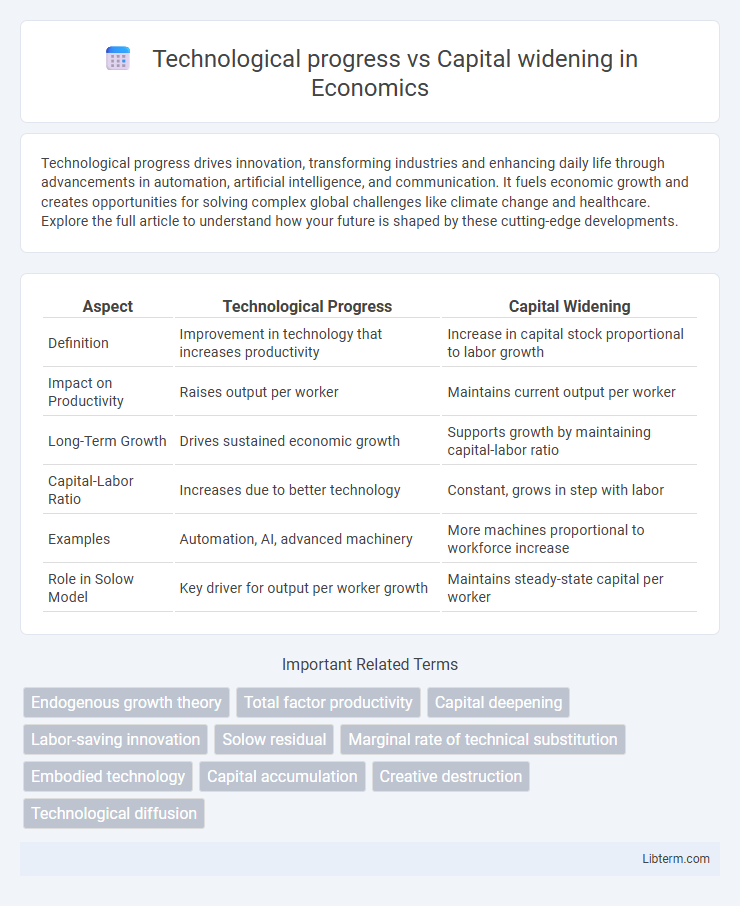Technological progress drives innovation, transforming industries and enhancing daily life through advancements in automation, artificial intelligence, and communication. It fuels economic growth and creates opportunities for solving complex global challenges like climate change and healthcare. Explore the full article to understand how your future is shaped by these cutting-edge developments.
Table of Comparison
| Aspect | Technological Progress | Capital Widening |
|---|---|---|
| Definition | Improvement in technology that increases productivity | Increase in capital stock proportional to labor growth |
| Impact on Productivity | Raises output per worker | Maintains current output per worker |
| Long-Term Growth | Drives sustained economic growth | Supports growth by maintaining capital-labor ratio |
| Capital-Labor Ratio | Increases due to better technology | Constant, grows in step with labor |
| Examples | Automation, AI, advanced machinery | More machines proportional to workforce increase |
| Role in Solow Model | Key driver for output per worker growth | Maintains steady-state capital per worker |
Defining Technological Progress and Capital Widening
Technological progress refers to improvements in production processes and innovation that increase output without increasing input quantities, thereby enhancing total factor productivity. Capital widening involves increasing the quantity of capital inputs, such as machinery or infrastructure, proportionally with labor to maintain the same capital-to-labor ratio and sustain output growth. While technological progress drives efficiency and long-term economic growth, capital widening focuses on expanding capital resources to support larger-scale production.
Historical Context: Evolution of Economic Growth
Technological progress drives economic growth by enhancing productivity through innovation and improved methods, enabling more output from the same input. Capital widening, characterized by increasing the quantity of capital stock, expands economic capacity but does not improve efficiency or productivity per unit of input. Historically, the Industrial Revolution marked a shift from capital widening to technological progress as the primary engine of sustained economic growth, highlighted by advancements in machinery, transportation, and communication infrastructure.
Mechanisms of Technological Progress
Technological progress drives economic growth by enhancing total factor productivity through innovation, improved processes, and the development of new products. Key mechanisms include research and development (R&D) investments, knowledge spillovers, and human capital accumulation that boost efficiency beyond mere input increases. Unlike capital widening, which expands physical capital, technological progress transforms production capabilities, enabling higher output with the same inputs.
Capital Widening: Concept and Implications
Capital widening refers to the increase in the quantity of capital assets to equip a growing labor force without enhancing the productivity of each worker. This form of capital accumulation maintains a steady capital-to-labor ratio but does not lead to productivity improvements or technological innovation. The implications of capital widening include sustaining current output levels per worker while supporting economic expansion through workforce growth rather than efficiency gains.
Impact on Productivity and Economic Output
Technological progress drives productivity growth by enabling more efficient production processes and innovation, leading to sustained increases in economic output beyond mere input expansion. Capital widening, involving increased capital stock proportional to labor growth, enhances output by maintaining existing productivity levels but does not improve efficiency per worker. Empirical studies show economies achieve long-term growth primarily through technological advancements rather than capital accumulation alone.
Labor Market Effects: Skills and Employment
Technological progress drives demand for high-skilled labor by automating routine tasks and fostering innovation, leading to job polarization characterized by growth in both high- and low-skilled occupations. Capital widening, involving increased investment in existing technologies, expands employment but primarily enhances productivity in established industries without significantly shifting skill demands. Labor markets experience dynamic shifts as technological progress reshapes skill requirements, creating both opportunities for skilled workers and challenges for those with obsolete skills.
Capital Deepening vs. Capital Widening
Capital deepening involves increasing the amount of capital per worker, enhancing productivity through technological progress and more sophisticated equipment, leading to sustained economic growth. In contrast, capital widening maintains the capital-to-labor ratio by expanding the capital stock proportionally with the workforce, supporting growth by accommodating more workers without improving productivity. Technological progress drives capital deepening by introducing innovations that improve capital efficiency, while capital widening primarily addresses quantitative growth through broader capital allocation.
Case Studies: Examples from Developed and Developing Economies
Technological progress drives productivity growth by introducing innovation and efficiency improvements, as demonstrated by case studies in developed economies like the United States, where advancements in information technology have significantly boosted output. In contrast, capital widening, characterized by increasing capital inputs without major innovations, plays a larger role in developing economies such as India, where expanding infrastructure and machinery adoption enhances production capacity but yields slower productivity gains. Comparative analysis highlights that technological progress underpins sustainable long-term growth, while capital widening offers immediate but limited improvements in economic development.
Policy Implications: Encouraging Sustainable Growth
Technological progress enhances productivity by enabling innovation and improving resource efficiency, while capital widening expands physical assets to support a growing workforce. Policy frameworks should prioritize investment in research and development, digital infrastructure, and education to foster scalable technological advancements that sustain long-term economic growth. Encouraging sustainable practices through regulation and incentives can balance resource use, ensuring inclusive growth without depleting environmental capital.
Future Trends: Integration of Technology and Capital Expansion
Future trends indicate a synergistic integration of technological progress and capital widening, where advancements in AI, automation, and IoT drive increased capital investment in smart infrastructure and digital platforms. Capital expansion facilitates scalable deployment of innovative technologies, enhancing productivity and economic growth across industries such as manufacturing, healthcare, and finance. This convergence promotes sustainable development through optimized resource allocation and accelerated innovation cycles in the evolving global economy.
Technological progress Infographic

 libterm.com
libterm.com